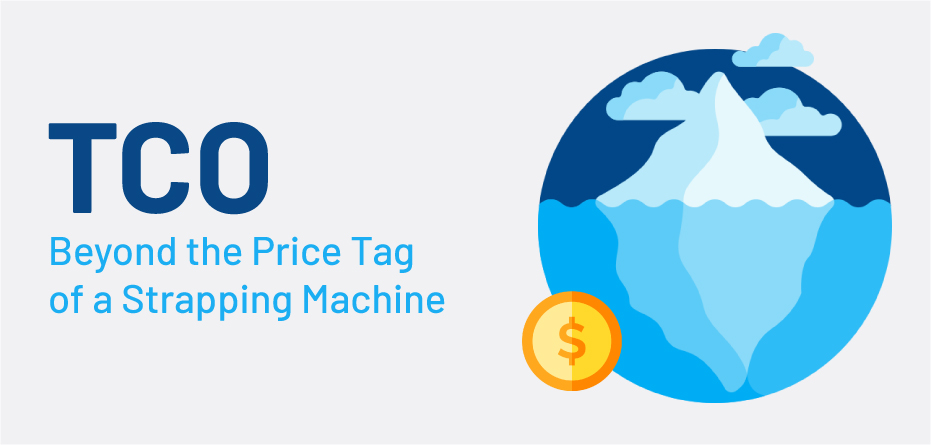Total Cost of Ownership: Beyond the Price Tag of a Strapping Machine
Investment decisions are often heavily influenced by supplier quotations for the initial purchase. While up-front costs are important, the performance of strapping equipment over its operating life may significantly change investment economics. A broad-based analysis following Total Cost of Ownership (TCO) principles is advisable to help make the best choice.
TCO is difficult and often impossible to nail down quantitatively, but a review of its different elements can provide valuable insight into the comparative costs and benefits of different supplier proposals. Summing up the quantitative and qualitative aspects of quoted systems’ lifetime costs will often lead to a different choice than if the focus is primarily on the initial investment.
The basic elements of TCO include:
- Initial investment
- Operating costs
- Reliability and the cost of downtime
- Maintenance costs: labor and parts
- Productive life
Let’s take a brief look at each one and consider how they can help system buyers reach the best investment decision.
Initial Investment
This aspect of the project is the most quantifiable. Most important is to define the system requirements accurately so that suppliers quote appropriate solutions. In addition to the equipment purchase price, consider space requirements, installation, and training requirements.
Make sure that up and downstream material handling equipment integrates with the strapping system to minimize production disruptions. EAM-Mosca recently sold an automatic system to a soft goods warehouse where the up-front equipment quote was significantly higher than the competition because of some additional conveyor and controls offered. A trial proved the benefits through improved product flow, fewer operating disruptions, and better-looking finished packages, making the customer happy to have considered the bigger picture in its decision.
Operating Costs
Elements of operating cost include utility costs, system speed vs. production requirements, and the cost of strapping.
Power usage is often available from equipment manufacturers. Electrically powered systems are typically lower power users than hydraulic or pneumatic machinery.
System speed should be matched to production processes with some allowance for peak requirements. Critical processes may be best served by some redundancy in the system to assure the ability to meet the highest production demands.
Strapping cost is another important variable. Be sure the equipment considered can operate efficiently with the lightest strap needed to secure the package. Some equipment must run heavier than necessary straps for reliability reasons, unnecessarily increasing both cost and consumable usage. For example, changing to Mosca equipment enabled a major poultry company to reduce the strap size used from 9 to 5mm wide, saving 25% in strap costs while reducing plastic use by nearly half.
Reliability
System reliability is a critical variable in investment success. Downtime can impact production quantities, costs, and customer service levels. Take the time to investigate the reliability of various manufacturers’ equipment/strap systems. Suppliers can often supply references to testify to their product performance, and some will offer to do a no-charge trial as a real-life demonstration.
The poultry company referred to above was having to run excessive overtime on their planned shifts because downtime on the packaging line delayed processing completion of their perishable product. An in-plant trial demonstrated Mosca’s reliability, enabling the plant to eliminate the overtime, and led the company to convert to Mosca equipment across their multi-plant network.
Maintenance Costs
Maintenance costs, including parts and labor, in-house and contracted, can vary dramatically among manufacturers. Beyond production speeds, be sure the equipment you consider is built for the volume requirements of the operation. Inexpensive equipment may be ok for low volume or occasional use, but for high production operations, it is best to consider suppliers and equipment that is proven in high production environments. Check out the construction of the equipment under consideration. Ask questions about the ruggedness and accessibility of key operating components and assemblies. Be sure the manufacturer has top-notch technical service support in the field and via phone and or internet. If your operation works on a 24-hour schedule, look for around-the-clock service availability from the supplier. Discuss service intervals to get a feeling for the day-to-day reliability of the equipment. Suppliers that recommend monthly or quarterly service contracts vs. one that recommends semi-annual or annual planned service calls may have major differences in parts and labor costs. Differences are worth investigating.
A simple tip for evaluating differences in equipment is to assess the smart use of technology to simplify the mechanics of machinery. Mosca equipment, for example, uses dc direct drives instead of mechanical transmission systems, reducing wear, dirt, and noise in bundling and unitizing systems. Ditto for their Sonixs ultra-sonic strap sealing system, which is cleaner, quieter, and with a typical operating life of more than 5 million cycles, much longer-lived than competitive friction and heat seal welding systems.
Productive Life
The final issue to consider is working life. For strapping equipment, the number of strapping cycles is a good indicator of suitability for a given application as well as for the length of reliable service. Again, the best choice depends on the demands of the operation. At EAM-Mosca, where the focus is on demanding production requirements, cycle counts in excess of a million per year are common. The company has many machines running reliably with north of 10 million cycles and services equipment with lifetime cycle counts of more than 25 million cycles. In any case, considering the length of productive service in buying decisions can make a difference in long-term investment success.
The Take-away
The point is that whatever the requirement, it makes sense to do a TCO evaluation of potential solutions vs. the requirements of the process to be served in order to make the optimum investment choice. While pure numeric evaluations are impractical, comparison of supplier costs and capabilities across basic TCO elements will often lead to a better investment outcome than focusing on the upfront price alone.
Want to find out more?


